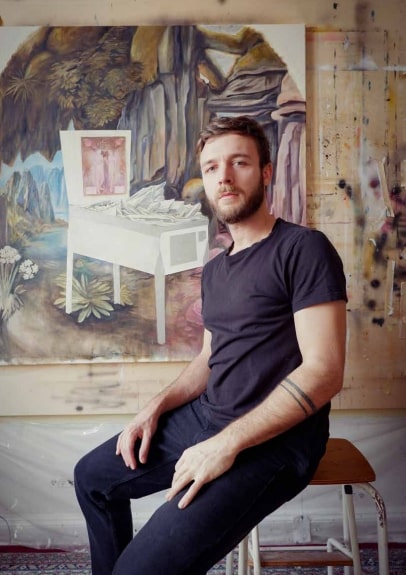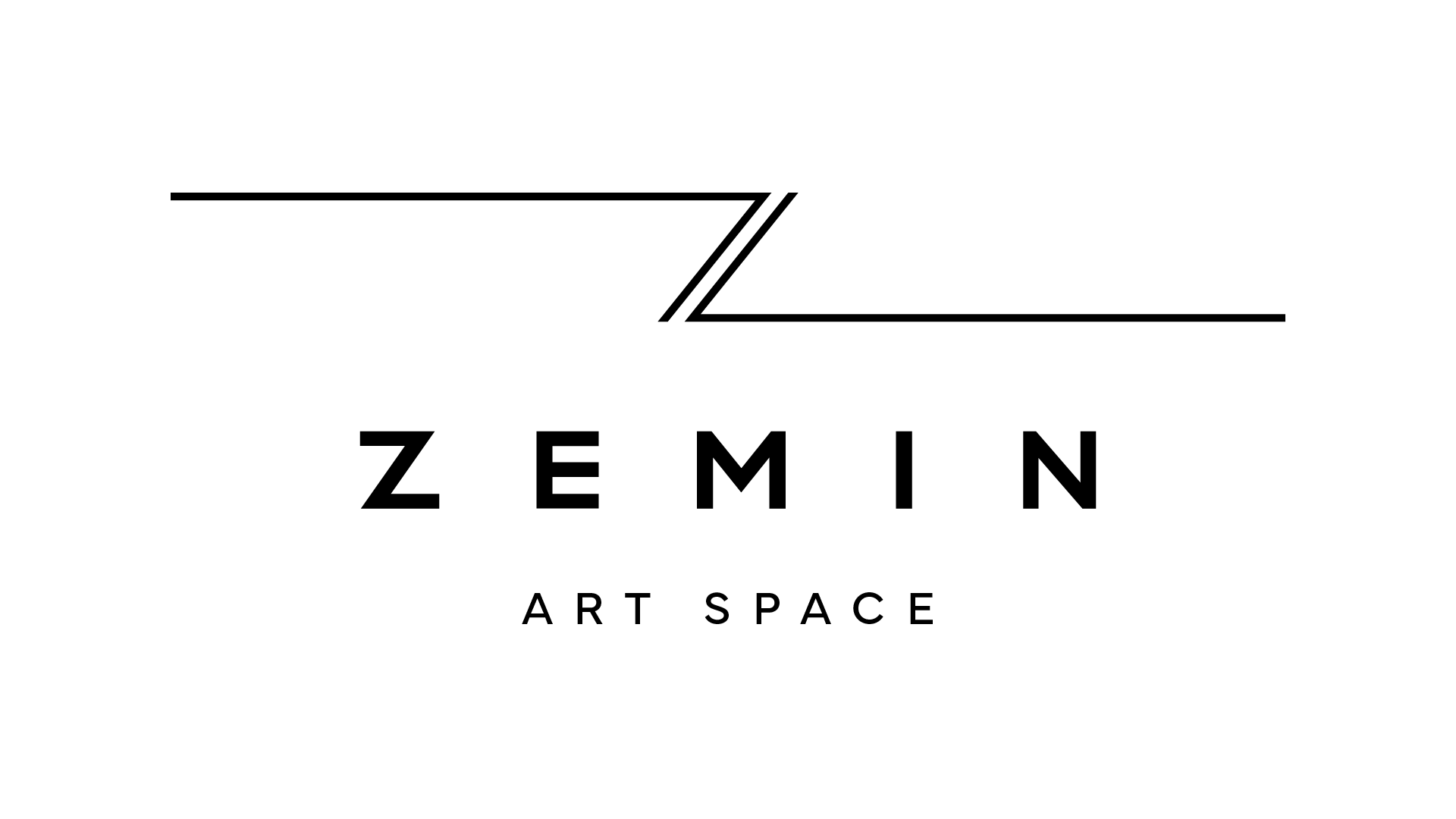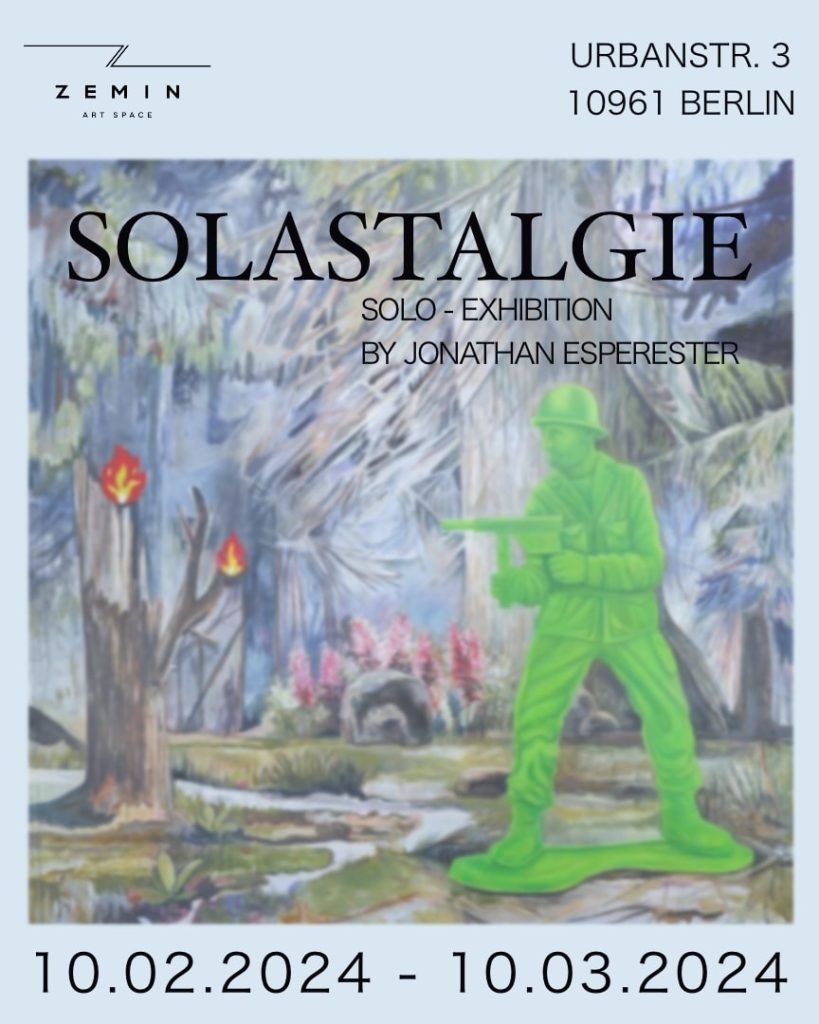
In my collage-like paintings I have great interest in the materiality of the image. Here I try to make the process visible on the canvas – different layers with different materials (oil, acrylic, airbrush, ink, varnish, Windowcolor, foil, etc.) are placed on top of each other and create a tension between surface and spatiality. In addition, I work with small objects, which stand on pedestals attached to the picture, and form a kind of „totem“ for the respective image. Thematically, I am interested in general in „magical thinking“ in our current time. For this I deal in particular with the human perception and classification of reality. Man-made categories such as „naturalness“ carry for me an ambivalence that reflects the enormous diversity of the world and thus develop a kind of magic. I try to capture this in objects and present them in stage-like spaces as part of an unknown but mystical ritual. Through the often nostalgically charged objects, the viewer is enabled to find an emotional access to my surreal visual worlds and to question their own perception. My work results in search of the fantastic element, which makes the everyday seem magical.
1/1 Exhibition: Solastalgie
The exhibition „Solastolgie“ is the conclusion of Jonathan Esperester’s last two years of work. For this he has been particularly interested in man made categories like naturalness and the imitation of nature, environment and wildlife. In the act of copying lies for him a special attentiveness – the transformation of for humans incomprehensible complexity of organic processes is stylized and transformed into kitschy objects. This resembles the overload and resulting into rage to tame and subjugate nature. Esperester’s paintings and objects are filled with the playful spirit of my childhood – the water pinball game, the model train, the terrarium: all these are playful approaches to turn the environment into small and controllable parts.The criticism lies not in the playfulness, but in the fact that people also apply this approach onto everyday life. Nature is irretrievably destroyed and reshaped in order to generate benefit. What remains is curated naturalness, gardens of undercomplexity. In the essay collection „The arts of living on a damaged planet“ the editor Anna Tsing shows with wonderful examples a way out of this vicious circle. First of all the advanced destruction of nature is acknowledged and named. What is then derived from it, however, is not powerlessness, not pure mourning for the past, but living practices of curiosity and empathy. In her book „The future of nostalgia“, the artist Svetlana Boym provides the ideal mindset for this state of living: as in solastalgia, mourning, like the feeling of nostalgia, must not be paralyzing – it is not predetermined to turn into an ideologized dystopia of backwardness. Not restorative nostalgia, but reflective nostalgia should lead the way from the past into the future. The act of playing, which constitutes and accompanies the human being, does not need to be a sign of infantile destructiveness – under the right conditions, it can also offer a solution: in play, the human being can take on other perspectives, empathically and performatively put himself in the place of non-human beings, and curiously experience new things. The prerequisite for this is a humbled state of being. From the self-understanding that humans possesses only a fraction of knowledge, a magical understanding of the environment and everything past, present and future can arise. The world, with all its interconnections, complexity and contradictions can be enchanted again. The Enlightenment is not to be turned back – rather, the Enlightenment character is to be rethought for all human and non-human allies: without the claim of domination and the rage of submission. To express this theoretical approach Jonathan Esperester shows a selection of his paintings in combination with objects and a performance. The paintings are to be an example of playful curiosity, whereby the previous destruction is always part of the surreal world. The associative composition is reinforced by the various nostalgically charged objects. In addition, small pedestals with little figures are part of some of the paintings. The figures, which are always stylized replicas of nature and animals, become a kind of altar in combination with the pictures – a mythically charged place is to be created, which does not spread rigid ideologies, but rather celebrates curiosity and the tolerance of ambiguity.


